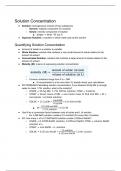Notes de cours
CHEM 130 Chapter 8: Solutions and Aqueous Reactions
- Cours
- Établissement
Class notes for Chapter 8: Solutions and Aqueous Reactions in the class General Chemistry: Macroscopic Investigations and Reaction Principles (CHEM 130) at the University of Michigan. Topics covered include solutions and solution concentration/dilutions, aqueous solutions, precipitation reactions, ...
[Montrer plus]



